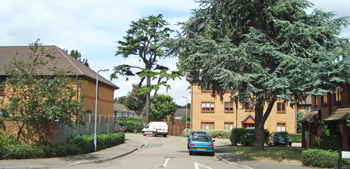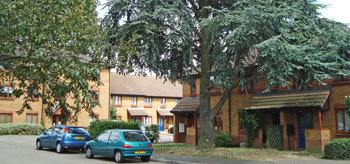Cheshunt Cottage Hospital
Church Lane, Cheshunt, Waltham Cross, Herts EN8 0DL
Medical
dates:
Medical
character:
General. Later, G.P., then Out-Patients only.
Cheshunt Cottage Hospital opened
in 1889 on a 2-acre site. The two-storey building had 6 beds and
had cost £1,010 to build.
The ground floor contained two wards of 3 beds each, a Nurses' Sitting Room, a Committee Room (which was also used as the operating theatre), a small drug store and a kitchen. The WCs and sinks were located in small wings projecting to the north of the wards, while the connecting lobbies served as both lavatories and for access to the garden. On the first floor there were two rooms, formed in the central portion of the high-pitched roof.
The Hospital was funded jointly by voluntary contributions and from endowments of about £80 a year from donations by Lady Meux, Messrs J. and C. Dowra, Mrs Baker, Mr and Mrs J. Gayler and Thomas Leigh, and from legacies from Miss Sanders, Mrs Hird, John Crewtare and W. Stevens.
As with other voluntary hospitals, patients with alcoholism, mania, epilepsy, contagious or infectious disease were not eligible for admission, not any woman in the advanced stage of pregnancy.
The Hospital was enlarged in the 1920s. It then had 15 beds (including cots). In 1928 the average length of stay for each in-patient was 16 days, with an average of 9 patients resident daily - a bed occupancy of 60%. The average weekly cost of an in-patient was £3 12s 0d (£3.60), compared to £3 9s 10d (£3.49) in 1927.
In 1928 Major and Mrs Savory donated a wireless set for the patients. Two members of the Hospital Committee agreed to pay for its installation. Other gifts for the Hospital included fruit, vegetables, groceries, magazines, jigsaws, a pair of steps and a piano.
In 1939, at the outbreak of WW2, the Hospital joined the Emergency Medical Service with 16 beds.
In 1940 the visiting committee from the King's Fund found the Hospital old-fashioned in appearance, with the air of a converted private house. The operating theatre was inadequate and there was no X-ray Department. The Out-Patients Department was a small room with a couch in which casualities were also received. Local General Practitioners (G.P.s) undertook minor operations, but major surgery was performed by London consultants. There were no other hospitals close at hand - the nearest voluntary hospital was at Hertford and the nearest infirmary the Public Assistance Institution at Ware.
The nursing staff consisted of a Matron, 2 Sisters, an Assistant Nurse and a probationer. The Nurses' Home was a pleasant private house in the grounds. It had 5 bedrooms. Matron and the senior nurses slept on the ground floor, while the junior nurses and maids slept in a dugout.
During the war the buildings suffered some bomb damage.
In 1944 the average bed occupancy was 44%. An anonymous gift of gas and oxygen apparatus proved most useful for operations.
In 1946 the average weekly cost of an in-patient was £7 11s 2d (£7.56), which had risen to £9 19s 2d (£9.96) by 1947.
A temporary X-ray Department was built in 1947. Throughout the year the average bed occupancy was 50%. A private patient was charged 5 gns (£5.25) a week for a room.
The Hospital joined the NHS in 1948 under the control of the Enfield Group Hospital Management Committee, part of North East Metropolitan Regional Hospital Board.
In 1974, following a major reorganisation of the NHS, it came under the management of the Enfield and Haringey Area Health Authority, part of the North East Thames Regional Health Authority. It became a G.P. hospital with 14 beds.
In 1981 the in-patient beds came under threat of closure by the Area Health Authority, which was facing financial restrictions, but a petition organised by the local population, including the G.P.s and nurses, temporarily deferred this action.
The Area Health Authorities were abolished in 1982 following another major reorganisation of the NHS, and the Hospital came under the control of the Enfield District Health Authority. Despite the protests, the beds closed in 1983. The Hospital continued to deal with out-patients only.
In 1994, with another reorganisation of the NHS and the introduction of the marketplace system within it, the Hospital came under the auspices of the New River Health Authority, part of the North Thames Regional Health Authority.
It finally closed in 1998 when the new Cheshunt Community Hospital opened in King Arthur Court.
Present status (July 2009)
The ground floor contained two wards of 3 beds each, a Nurses' Sitting Room, a Committee Room (which was also used as the operating theatre), a small drug store and a kitchen. The WCs and sinks were located in small wings projecting to the north of the wards, while the connecting lobbies served as both lavatories and for access to the garden. On the first floor there were two rooms, formed in the central portion of the high-pitched roof.
The Hospital was funded jointly by voluntary contributions and from endowments of about £80 a year from donations by Lady Meux, Messrs J. and C. Dowra, Mrs Baker, Mr and Mrs J. Gayler and Thomas Leigh, and from legacies from Miss Sanders, Mrs Hird, John Crewtare and W. Stevens.
As with other voluntary hospitals, patients with alcoholism, mania, epilepsy, contagious or infectious disease were not eligible for admission, not any woman in the advanced stage of pregnancy.
The Hospital was enlarged in the 1920s. It then had 15 beds (including cots). In 1928 the average length of stay for each in-patient was 16 days, with an average of 9 patients resident daily - a bed occupancy of 60%. The average weekly cost of an in-patient was £3 12s 0d (£3.60), compared to £3 9s 10d (£3.49) in 1927.
In 1928 Major and Mrs Savory donated a wireless set for the patients. Two members of the Hospital Committee agreed to pay for its installation. Other gifts for the Hospital included fruit, vegetables, groceries, magazines, jigsaws, a pair of steps and a piano.
In 1939, at the outbreak of WW2, the Hospital joined the Emergency Medical Service with 16 beds.
In 1940 the visiting committee from the King's Fund found the Hospital old-fashioned in appearance, with the air of a converted private house. The operating theatre was inadequate and there was no X-ray Department. The Out-Patients Department was a small room with a couch in which casualities were also received. Local General Practitioners (G.P.s) undertook minor operations, but major surgery was performed by London consultants. There were no other hospitals close at hand - the nearest voluntary hospital was at Hertford and the nearest infirmary the Public Assistance Institution at Ware.
The nursing staff consisted of a Matron, 2 Sisters, an Assistant Nurse and a probationer. The Nurses' Home was a pleasant private house in the grounds. It had 5 bedrooms. Matron and the senior nurses slept on the ground floor, while the junior nurses and maids slept in a dugout.
During the war the buildings suffered some bomb damage.
In 1944 the average bed occupancy was 44%. An anonymous gift of gas and oxygen apparatus proved most useful for operations.
In 1946 the average weekly cost of an in-patient was £7 11s 2d (£7.56), which had risen to £9 19s 2d (£9.96) by 1947.
A temporary X-ray Department was built in 1947. Throughout the year the average bed occupancy was 50%. A private patient was charged 5 gns (£5.25) a week for a room.
The Hospital joined the NHS in 1948 under the control of the Enfield Group Hospital Management Committee, part of North East Metropolitan Regional Hospital Board.
In 1974, following a major reorganisation of the NHS, it came under the management of the Enfield and Haringey Area Health Authority, part of the North East Thames Regional Health Authority. It became a G.P. hospital with 14 beds.
In 1981 the in-patient beds came under threat of closure by the Area Health Authority, which was facing financial restrictions, but a petition organised by the local population, including the G.P.s and nurses, temporarily deferred this action.
The Area Health Authorities were abolished in 1982 following another major reorganisation of the NHS, and the Hospital came under the control of the Enfield District Health Authority. Despite the protests, the beds closed in 1983. The Hospital continued to deal with out-patients only.
In 1994, with another reorganisation of the NHS and the introduction of the marketplace system within it, the Hospital came under the auspices of the New River Health Authority, part of the North Thames Regional Health Authority.
It finally closed in 1998 when the new Cheshunt Community Hospital opened in King Arthur Court.
Present status (July 2009)
The Hospital has been demolished and its site redeveloped as Cottage Gardens.

New housing along a new road - Cottage Gardens - occupies the site of the Hospital (above and below).

Burdett H 1896 Cottage Hospitals, 3rd edn. London, Scientific Press.
http://hansard.millbanksystems.com
www.flickr.com
www.harlowstar.co.uk
Return to home page